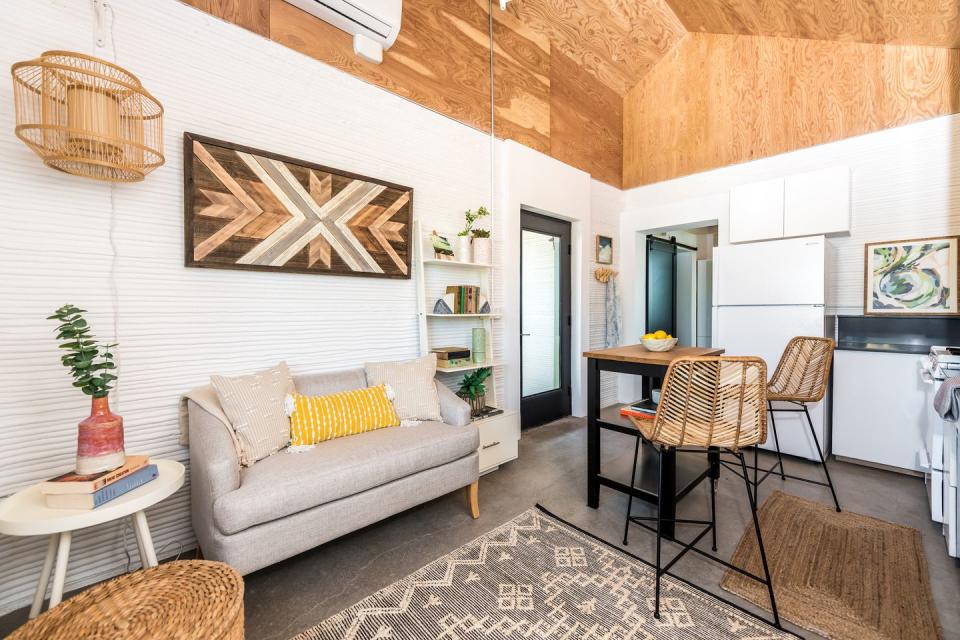Yes, You Can Order a 3D-Printed Guest House

The concept of 3D printing—or additive manufacturing, as it’s formally known—isn’t a particularly new one. The first 3D printers were built in the 1980s, though the technology wasn’t refined to the point of mass consumerism until the last decade or so. And while 3D printers can now be found in laboratories, classrooms, and architecture studios around the world for printing all kinds of small parts, designers are looking to print the next big thing—quite literally: They’re looking to 3D print houses.
The 3D-printed house industry is still very much in its infancy, though numerous companies are experimenting with new techniques, methods, and hardware in order to advance the technology rapidly. And although we’re not quite at the point where just anyone can order up a 3D-printed home, we can’t help but think ahead to when we can—and we suspect it’ll be ideal for a guest house.

The Past, Present, and Future of 3D-Printed Houses
In essence, 3D-printed houses are made the same way any other 3D-printed object is made: A material (like concrete or plastic) is extruded through a nozzle that can move in three dimensions to print an object. But in the case of homes, the printer needs to be a bit larger and a bit hardier, given that it needs to operate outdoors on varied terrain.
A number of companies have been dabbling in the house-printing field for the past few years: Gensler built a 3D-printed office in Dubai in 2016; DUS Architects constructed an urban cabin from 3D-printed bioplastic that same year; CLS Architetti and Arup debuted a 3D-printed house prototype at the 2018 Milan Design Week; and France’s University of Nantes developed a 3D-printed residence called Yhnova, whose occupants moved in in 2018. Today, even more companies are developing 3D-printed homes, including Chinese company WinSun, San Francisco– and Moscow-based Apis Cor, and Austin-based ICON.
Of these, ICON is the furthest along in its technological development, having already commenced construction on two full neighborhoods of 3D-printed homes. One is a collaboration with nonprofit New Story to build a 50-home neighborhood in Tabasco, Mexico, for families in need. The other is a collaboration with nonprofit Mobile Loaves & Fishes in ICON’s hometown of Austin, Texas, building a community for the homeless. These neighborhoods demonstrate the practicality of using 3D-printed homes for social good, whether that’s building comfortable housing for impoverished families or for people displaced by natural disasters or war, thanks to their affordability and the speed at which they can be built.
“While ICON is still in its early stages, the company’s aim is to work with many builders, developers, architects, and organizations to utilize ICON's technology to build homes of many sizes, at varying price points, and with ultimate design freedom to create anything you can dream up,” says Jackson.
Beyond their humanitarian purposes, other practical uses of 3D printed homes include potential Mars habitats—NASA, for instance, has taken an interest in the technology, since printing structures on Mars would be a lot more convenient than flying all the raw materials there. But in terms of the everyday user, one very realistic use would be building a small guest house on your property.
Pros to 3D-Printed Houses
Their construction method is sustainable. “Construction waste from building an average American home is four tons,” says Jackson. “With 3D printing, you print what you need to the drop and then stop.”
They can be built quickly. Current technology allows the framework of a small 400-square foot home to be printed in just 24 hours, though the final touches might take a bit longer. “The finish out of the homes will depend on the timing of the tradespeople and their schedules, but typically is around a few months,” says Jackson.
They’re more affordable than stick-built houses. By some professionals’ estimates, construction costs for a 3D-printed house could be half that of those for a stick-built house (the term for a home constructed with wooden frames). A 3D-printed house could potentially even get into the four-digit range.
There’s more flexibility in terms of design. Most stick-built houses feature rectilinear geometry, because straight lines and right-angles are the easiest and most convenient shape for that style of construction. Any deviation, say a curved wall, requires a lot more effort and money. But 3D-printed walls can take on any shape with ease, thanks to the precise movements of the machine.
It’s easy to make last-minute design changes. Gone are the days when clients throw architects a curveball in the ninth inning. “If you have a new idea and want to tweak the design, it’s incredibly simple to amend the design file,” says Jackson. “And the best part, the printer doesn’t mind!”
Cons to 3D-Printed Houses
There’s not much flexibility in terms of material—yet. Right now, printers can only build walls from concrete or plastic, so if you’re looking to use wood, brick, or stone, you’re out of luck for now.
Not all of a house’s components can be 3D-printed. Only the walls of a 3D-printed house can be 3D-printed as this time, meaning a construction crew needs to finish all the other odds and ends—doors, windows, plumbing, electricity. This contrasts with a prefabricated home, for instance, where many of those components are taken care of in the factory, prior to the on-site build.
Should I Use One as a Guest House?
While 3D-printing technology on the scale of an entire home is not quite ready for personal use, it’s not unreasonable to assume it’ll get there one day soon, and it’ll likely be a relatively quick, affordable, and sustainable option for homeowners looking to add a guest house to their property.
Follow House Beautiful on Instagram.
You Might Also Like

